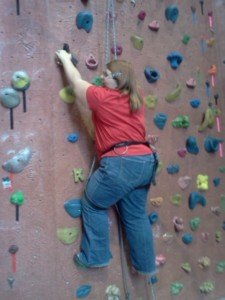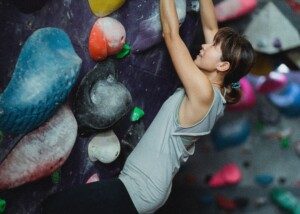
These wall climbing guidelines are specifically for fat or plus size women AND men who wish to pursue this very fun sport.
I used to do a lot of climbing, and though not overweight, I learned a lot in the four years I spent, week after week, climbing all sorts of wall routes.
I achieved a strong intermediate level of skill at top roping. This means that I was regularly top roping to completion, on a first attempt, new routes that were rated 5.10 (A, B and sometimes C).
I was able to work some 5.11’s on top rope, getting to the top (but never on a first try with a newly created 5.11 route).
I did lead climbing on some 10’s, a few 11’s. I also did all kinds of routes such as slabs, corners and overhangs.
Basic Climbing Guidelines for Overweight Beginners
First and foremost, don’t say, “I’m too fat to climb.”
If you’ve ever been in a climbing gym, you will have noted that routes are rated with numbers which usually go down as far as 5.4, maybe a little lower.
These are easy, and parents have their newbie children climbing them.
But they are also for adults who are new to this sport.
These easy routes consist of large, comfy hand-holds and foot-holds.
The issue, then, is stamina, even though a very overweight person may have difficulty just making a few successive moves due to their size.
But with grit and determination, it can be done, assuming that you are not so obese that you have difficulty just walking.
Expect to fatigue quickly. Don’t let this discourage you! After all, the human body is NOT designed to ambulate vertically. We are not squirrels.
You WILL fatigue very fast. Simply sit back in your harness and rest, then resume.
It may take an overweight newbie quite a while to reach the top of the gym’s easiest route, especially if it includes a slight overhang.
There is nobody timing you.
There is no time limit on the route.
If you need 20 minutes, then you take 20 minutes.
Consider it a workout routine.
Expect your forearms especially to quickly burn. This is because you’re using them in a way that you’ve never done before. This fast on-fire feeling also occurs to thin beginners.
The main reason you’ll feel your forearms going dead very quickly is because people who are new to wall climbing will invariably try to muscle up a route, especially a route with big hand-holds.
They will attempt to pull themselves up with their arms, letting their legs drag below them. This is not how to efficiently climb a wall.
However, learning the proper techniques will take time. Do not get in the habit of muscling up the route.
It is said that women climbers learn the techniques faster than do men because they lack the upper body strength to haphazardly muscle up the wall.
Body position, including that of the legs, is crucial for efficient wall climbing.
Even how you place your hand on particular hand-holds makes a big difference.
I can go on and on about the many very effective body movements that propel a person up a wall without any muscling-up, but let’s just keep the focus here on guidelines for overweight beginning climbers.
You will need to learn how to propel up with your legs. This will take time. But how strong must your legs be to learn leg techniques?
Chances are, your legs are already strong enough for most of the techniques.
The so-called loading and rocking-on of a leg are probably not one of them, but there are other lower body tricks you can do even if you’re overweight.
Do not try to muscle up the route. Otherwise you will become quickly defeated.
Choose easy routes to start off with, even if only kids are using them. Novice children flounder plenty on easy routes.
During your downtime at the gym, watch the movement patterns of experienced climbers. Compare them to struggling climbers. You will see a big difference.
If your feet are too large to fit into climbing shoes, then wear the thinnest possible sneakers (not running shoes or other athletic-type shoes)—but just the simplest house-type sneakers.
If you’re sketchy about attempting a top rope route, then start out with some “bouldering.”
Bouldering is more of a horizontal (or so-called traversing) style of climbing, where there’s no rope required, and you’re close to the padded floor.
Traversing or bouldering will strengthen your fingers, hands and other muscles, and give the newbie plus-size man or woman an opportunity to hone basic climbing skills.

























